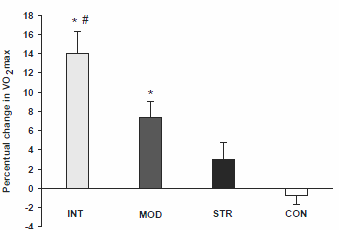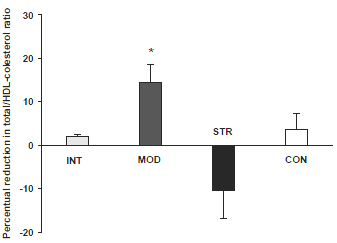|
Definition: "An ergogenic aid is any substance or phenomenon that enhances performance "
|
|
||||||||
08.04.2010 |
|
|
Strength training combines better with endurance training than with interval training
If you want to build your muscles and also lose fat, then it's not such a strange idea to combine strength training and endurance training. At least, you may reach this conclusion after reading the results a study from the University of Copenhagen, soon to be published in Medicine & Science in Sports & Exercise. The study compares the effects of 12 weeks of interval training, strength training and endurance training.
The researchers wanted to know more about the health effects of these three types of training, so they got 36 untrained men with an average age of 31 to train 3 times a week.
Interval training consisted of a warming up followed by five 2-minute sessions in which the subjects ran at an intensity of more than 95 percent of their maximal heart rate. Each training session lasted about 20 minutes.
The subjects in the endurance-training group ran three times a week for an hour at 65 percent of their VO2max.
The subjects in the strength training group only trained their legs, and did squats, hack squats, leg presses, leg extensions, leg curls and calf raises. For the first 4 weeks the subjects used weights for which they could manage 12-16 reps. For the last 8 weeks the subjects used weights for which they could manage no more than 6-10 reps.
Insulin sensitivity improved equally in the interval group and the endurance group.
When it came to cholesterol – and therefore the chance of developing cardiovascular disease in the long term – endurance training scored better. The relationship between ‘good’ [HDL] and ‘bad’ cholesterol [LDL] improved most in the group that ran for an hour 3 times a week at a moderate speed.
The fat free mass – in other words the muscle mass – increased most in the strength-training group. Fat mass decreased most in the endurance-training group. The table below summarises the changes in the body composition of the test subjects.
Interval training has been a hype for years, and it's not surprising if you consider that you gain positive effects in a short amount of time. But the researchers put the interval hype into perspective.
"The intense low volume training regimen had limitations and for the short-term intervention period it was less effective than prolonged training in relation to the treatment of hyperlipidemia and obesity", they write. "Furthermore 12 weeks of interval training had no impact on muscle mass or leg bone mass, whereas strength training besides increasing the subjects muscle mass also provided a significant osteogenic stimulus."
An hour’s running at a moderate speed might be a bit too much of a good thing for natural bodybuilders. Studies have shown that running for longer than 40-45 minutes breaks down muscle tissue. [Eur J Appl Physiol. 2005 Aug;94(5-6):505-13.] Researchers report good results in bodybuilders that run a couple of times a week for 40 minutes after their regular strength training. [J Appl Physiol. 1998 Aug;85(2):695-700.]
Source:
More:
|
|


